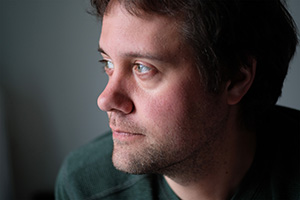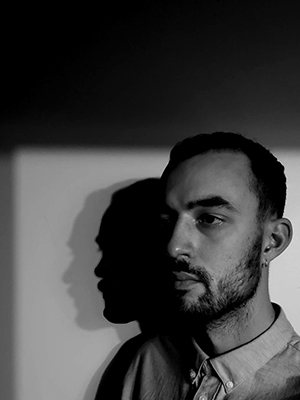Attuned to History & Landscape: Spencer Legebokoff in Conversation with Matthew Hollett

Malahat Review volunteer Spencer Legebokoff talks with Matthew Hollett, winner of the 2021 Open Season Award for Poetry with his poem, "Merchant Vessels."
Matthew Hollett is a writer and photographer recently transplanted from St. John’s to Tiotia:ke/Montréal. His work explores landscape and memory through photography, writing and walking. His first book, Album Rock (2018), investigates a curious photograph taken in Newfoundland in the 1850s, and he won the 2020 CBC Poetry Prize for Tickling the Scar, a poem about walking the Lachine Canal during the early days of the pandemic. His work has most recently appeared in Prism International and The Malahat Review.
Read what judge Rebecca Salazar had to say about his winning poem.
Your winning poem, “Merchant Vessels,” is rooted in the history of boats serving as transport between or around Newfoundland and Labrador and Nova Scotia. Your book Album Rock also blends nonfiction and poetry, focusing on a part of Newfoundland history. Album Rock sprouted from an interesting photograph from the 1850s. Did “Merchant Vessels” also begin with a photo? How did you come to learn about the histories of these vessels?
This poem didn’t begin with a photo, but I do have many photos and memories from trips on those ferries over the years. When I was a kid we drove down to Maine a few times on summer vacation, and I loved taking the ferry from Port aux Basques to North Sydney. It’s such a strange experience, especially for a kid—there’s the ritual of boarding, where you often have to wait for a long time in a winding line of vehicles, and then the crossing itself takes hours and hours. The ferries are huge, so there’s tons of time to explore. You can go up on deck and it’s loud and windy and the horizon goes on forever. But I remember being fascinated by the stuff on the walls—tourism ads with grandiose landscapes, plaques commemorating the vessel sunk in World War II, a photo of Joey Smallwood in his iconic glasses. There were also glass vitrines with scale models of ships. It all felt very old, and the decor didn’t seem to change much from when I was a kid to when those ferries were retired in 2010, so by the end they felt like time capsules from the 1980s. The place—and I think of the ferry as a place, not a vehicle—had a strong sense of its own esoteric history, like a tiny museum in an out-of-the-way town. I really enjoy going down those kinds of historical rabbit-holes.
There’s a portion of your poem that, rather than looking back into history, lingers on the future: “Environment critic Megan Leslie called it / an outrage: We’re talking about kids in India breaking down / that vessel. We shouldn’t be sending our problems / overseas. It’s morally and ethically reprehensible.” Judge Rebecca Salazar said that your poem “implicates the reader in the cost our transports will exact from the environment, and from future generations.” You’ve simultaneously respected the history of these vessels and questioned the ethics of their handling after retirement. As a writer, how do you strike a balance between these two perspectives—past and future, honour and ethics—when writing about real events?
“Between” is a perfect word to describe the ferries—I’m interested in writing about place, and the Marine Atlantic ferries exist between places in such a fascinating way. Some have been purpose-built in Quebec, some repurposed from Scandinavian shipping companies. They operate between Newfoundland and Nova Scotia for decades, becoming such a distinct yet detached part of the landscape. Then when they reach the end of their useful service, we dispose of them in this inglorious way—the Caribou and the Smallwood were sold to a company in the Marshall Islands, and sent to a notorious shipbreaking facility in India. It was a minor scandal at the time, because they had been sold on the condition that they would be scrapped in a responsible way.
It’s easy to say what happened to the ferries wasn’t our fault, but it also feels emblematic of the way we’re happy to overlook the more sinister effects of our actions on the world. Canadian history is of course full of this kind of thing, from colonization and “Canada 150,” to the residential school system, to the way we’re failing to adequately address the climate crisis. I don’t think it’s about “striking a balance” so much as interrogating the feel-good histories we’re often presented with.
The physical practice of walking is very Wordsworthian and meditative—did your walking practice change or influence your creative work differently when you relocated from St. John’s to Tio’tia:ke/Montréal, from coast to inland, from one island to another?
I’ve lived in a few different places now—St. John’s and Corner Brook, Halifax, Montréal, and a year in Arcata, California. Walking in each place feels different, and experiencing those differences often helps me see a place with fresh eyes. It’s hard to say how each place changes my creative practice, but I’m often writing in response to things I observe or photograph while walking, so the particular landscape and history of each place leaves an impression, for sure.
During the pandemic I’ve been spending a lot of time walking along the Lachine Canal, and its flatness and openness feels so different from St. John’s. The canal sometimes feels like a pinball machine of bridges and benches and bicycles, whereas when I picture walking in St. John’s I always imagine the North Head Trail, a steep, rugged path around the hillside below Signal Hill. On a wet, foggy morning with the water below full of minke whales, it can feel like visiting another planet. I rarely experience that kind of wildness here in Montréal, but on the other hand it has such vibrant parks and public spaces. I do love that Montréal is an island, even if it doesn’t often feel like one.
In a previous interview, you said “I used to describe myself as a visual artist who writes a lot, but I think I’m becoming more of a writer who takes a lot of photos.” Since that interview, you’ve published Album Rock (2018), won the 2020 CBC Poetry prize with “Tickling the Scar,” and have now won the 2021 Open Season Award for Poetry. What writing and/or photography projects are you working on now?
I’ve just finished Distancing on the Lachine Canal (https://www.matthewhollett.com/distancing/), a long visual essay about walking the canal during the first few months of the pandemic—the same walks that “Tickling the Scar” came from. It’s a work of creative nonfiction and photography, and the poem is in there, too.
Over the winter I’ve been taking a “nature writing” class remotely through Memorial University, but I’ve also been stuck at home a lot, so I’ve been writing indoorsy essays about house centipedes and the mouse in my ceiling, haha. I’m also working on a novel, which I find really difficult—it’s easier to find the edges of a piece of nonfiction, while fiction’s open-endedness can feel paralyzing. Why should this happen, and not that?
I’m curious to know which Canadian (or otherwise) poets and photographers you’re influenced by. How do they inform which subjects you choose to shoot and write about?
I’m intrigued by literary writers who work with photographs—W.B. Sebald is an example that comes up a lot, and The Rings of Saturn is a favourite of mine. But a writer I enjoy even more is Teju Cole—besides being a novelist and essayist he’s a photographer himself, and he combines these brilliantly in books like Every Day is For the Thief.
The “nature writing” class I mentioned has led me to Robin Wall Kimmerer’s Braiding Sweetgrass and Anna Lowenhaupt Tsing’s The Mushroom at the End of the World, two deep dives into natural history and the climate crisis that really made an impression on me. Also Angela Rockel’s Rogue Intensities, a deftly inquisitive book that makes great use of photography.
Over the past year I’ve also been watching a ton of movies. Documentary films can be so lyrical, building up visual metaphors by cutting from one subject to another, or threading disparate stories into a larger narrative. I’ve been thinking about these connections between cinema and poetry a lot, especially the work of Agnès Varda. The Gleaners and I is a marvellous, meandering film—warmly, even hilariously humanistic, and attuned to history and landscape—that feels like just the kind of thing I want to make.

Spencer Legebokoff
* * * * * * * *









